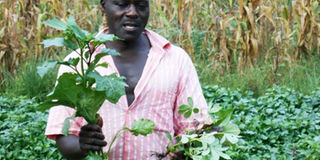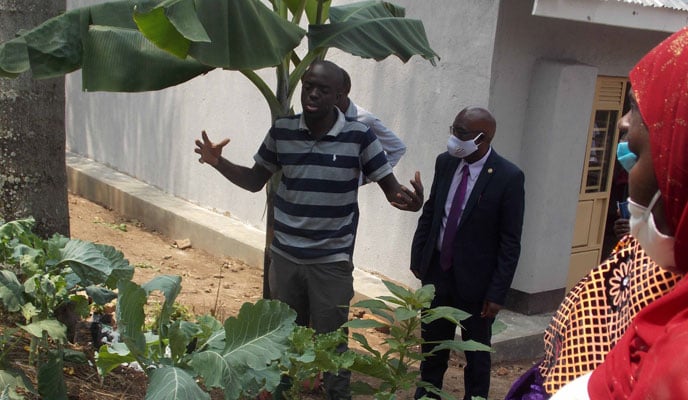Traditional food crops need attention too

Farmers are advised to create space between the rows for easy weeding. Photo / Lominda Afedraru
What you need to know:
- Many African native food crops seem neglected and are facing extinction. Scientific research is not carried out to improve their production and yield. They are not the focus of climate change mitigation efforts.
One of the main factors leading to food insecurity in Africa is the destruction of biodiversity by mindless usage of agricultural machines and chemicals. Speaking to Seeds of Gold a few weeks ago Athanasius Buliggwanga, a prominent farmer at Bbulamazzi Village near Kalisizo Town in Kyotera District said he had stopped using the spray pump to kill weeds in his garden because the herbicides indiscriminately killed all the plants growing as weeds.
They grow with weeds
Yet most of the traditional vegetables and many other food crops in Buganda normally grow together with the weeds and such vegetables include nsugga, jjobyo dodo, and mbooge. They are known to be a rich source of vitamins, minerals, and fibre. Some of them are also medicinal and many, such as mushrooms, are used during performance of a number of traditional rituals.
The irony is that Buliggwanga also has a separate and well-tended garden on his farm where he grows such crops as cabbages, sukuma-wiki, and carrots, among others --- which are not regarded as indigenous crops in Uganda. Why does he not also have a separate garden for the indigenous vegetables --- dodo, jjobyo, nsugga, mbooge and the others?
Not common
His reasons for not growing traditional vegetables are not different from those of another farmer in Lwengo District, John Ssentongo, of Lukindu Village near Kiwangala Trading Centre who told Seeds of Gold, “I cannot get their seeds because they are not commonly available in farmers’ shops. To grow them I will try to get their seeds myself and to take all the trouble to see how I can plant them and carry out all the suitable agronomical activities. But since they are not normally available in our food markets I even wonder if there will be enough people to buy them.”
Neglected vegetables
Many African native food crops seem neglected and are facing extinction. Scientific research is not carried out to improve their production and yield. They are not the focus of climate change mitigation efforts. Yet they are the food on which our forefathers fed and they are also not only part of our history but they are also our cultural heritage. And Uganda is naturally endowed with a rich diversity of food items that one hardly finds in the markets. In a little book published by Slow Food Uganda, titled: “Uganda --- From Earth to Table” the President of Slow Food Uganda, Edward Mukiibi, has writes: “Uganda is endowed with a range of climates and environments that encourage the flourishing of diverse forms of both flora, macro and micro, torrential and aquatic. The same conditions are ideal for the farming of a wide range of indigenous African food species that have supported local communities through tough times.”
Need to preserve them
Mukiibi goes on to say that as in other African countries, there are specific crops for each season, an edible insect for every time of the year and animals adapted to every specific type of vegetation, altitude and climate.
He believes that all these food products are closely linked to the culture, traditions, and beliefs of the Ugandan people and that the country’s 40-plus ethnic groups are all united by one important asset which is food diversity. They all have traditional food crops that are orphaned and neglected.
In Buganda and other parts of Uganda we have traditional crops such as mpindi (cow pea) whose tasty leaves can be steamed and dried. The dry leaves are then pounded and crushed into powder referred to as ggobe which can be used to enrich the taste of many sauce dishes in Buganda and in some other cultures.
As any visit to our food markets will reveal, there are hundreds of our food crops that are neglected and at risk of extinction.
Most of our long cherished food crops, fish species, and edible insects are considered less important by research organisations and government agencies which only promote the production of food crop and livestock species from foreign countries such as wheat, rice, dairy cows, among several others. When our traditional food crops disappear, so will our culture and identity. Our children and future generations ought to know about the tubers, the climbers, the insects, the birds, and the small animals in the wild that our forefathers cherished as delicious and nutritious food.
Writing in the same book as Mukiibi, Piero Sardo, President of the Slow Food Foundation for Biodiversity, says. “For us foreigners travelling in the countries of sub-Saharan Africa, it has never been easy to get an idea of African cuisine.”
What he means here is that when most tourists visit us the most probably expect not only to see the beauty of Africa and to see Africa’s wildlife, but also to taste some genuinely African food. When we go to Europe and America and other continents we eat wheat, meat, fruits, and vegetables produced in those countries. Some of the dishes there are very tasty and others are close to awful. They visit Africa expecting a taste of our traditional food crops, such as mugoyo ndaggu, kkobe, nswa, binyeebwa and mushroom etc. but instead in our hotels and restaurants they find carrots, cabbages, wheat, rice, and pizza.
Cowpea
Mpindi (cowpea) is one of our local pulses --- belonging to the family of legumes or beans. The seed is whitish khaki and in one pod some fifteen or so seeds may be found. The beans themselves make very good eating and can be cooked together with bananas or potatoes such as ordinary beans.




